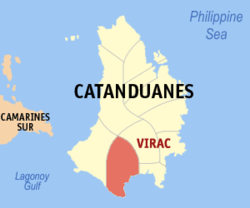Virac, Catanduanes
| Virac | |
|---|---|
| Municipality | |
 Location in the province of Catanduanes |
|
| Location within the Philippines | |
| Coordinates: 13°35′N 124°14′E / 13.58°N 124.23°ECoordinates: 13°35′N 124°14′E / 13.58°N 124.23°E | |
| Country | Philippines |
| Region | Bicol (Region V) |
| Province | Catanduanes |
| District | Lone district |
| Founded | Year 1775 |
| Barangays | 63 |
| Government | |
| • Mayor | Samuel Laynes |
| Area | |
| • Total | 152.4 km2 (58.8 sq mi) |
| Population (2015 census) | |
| • Total | 73,650 |
| • Density | 480/km2 (1,300/sq mi) |
| Time zone | PST (UTC+8) |
| ZIP code | 4800 |
| IDD : area code | +63 (0)52 |
| Website | www |
Virac is a first class municipality in the province of Catanduanes, Philippines. It is the capital municipality of the province and the most populous and fifth largest in land area. According to the 2015 census, it has a population of 73,650 people.
It has been said that Virac is a derivation of the word “Vidak” while others claim it is a contraction of the Spanish version of the word burac, meaning flower. A priest is on a quest for more information about the natives. Pointing to a tree, he asked what it was called and the natives replied, “Burac.” Thereupon, the priest made his first notation on his book of information “burac”.
Civilization first touched the island province of Catanduanes in the thirteenth century, with the arrival of the scions of ten Bornean datus who were then traversing through the islets of the Philippine Archipelago. By the middle of the fourteenth century, organized communities could be seen throughout Catanduanes – a consequence of the rapid development of Southeastern Luzon initiated by the Malay settlers.
Virac, the capital town of the island province of Catanduanes, started its primitive annals in pre-Spanish times when tribal chieftain Lumibao, scion of Datu Dumaguil who came to the Philippines with the 10 Bornean datus and his wife Milbigan settled near Vidak spring and founded the first civilized settlement with a score of servant followers and their wives.
It was the Spanish Conquistadores Juan de Salcedo who first brought Spanish galleons to the waters of Catanduanes in 1573. His purpose then was to capture and punish pirates who carried on their nefarious trade in Camarines Sur, Sorsogon and Western Catanduanes. His galleon returned a few weeks later – this time, his mission was to spread the Catholic faith.
While at bay, the port guard saw smoke rising from the mountain Eli. After dropping anchor, the Spaniards tracked down footprints from the shore which reached a sitio called Vidak. They eventually came upon a large kaingin in Timbean, situated between the barangays of Danicop and Calatagan.
...
Wikipedia

